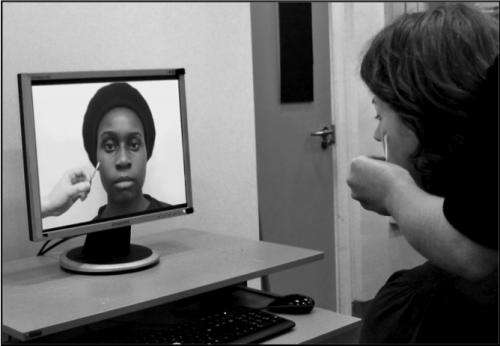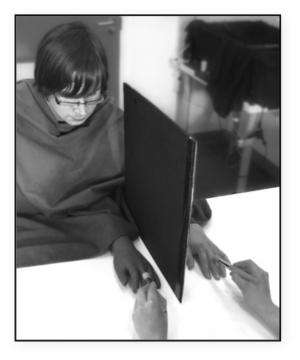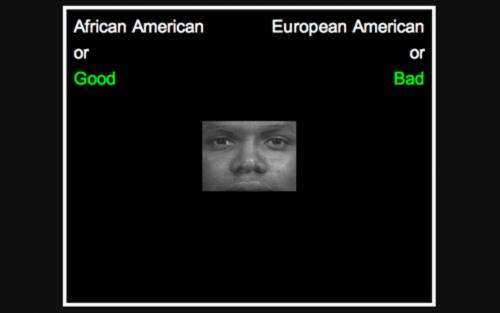Virtual bodyswapping reduces bias against other races

In 1959, John Howard Griffin, a white American writer, underwent medical treatments to change his skin appearance and present himself as a black man. He then traveled through the segregated US south to experience the racism endured daily by millions of black Americans. This unparalleled life experiment provided invaluable insights into how the change in Griffin's own skin color triggered negative and racist behaviors from his fellow Americans.
But what about the changes that Griffin himself might have experienced? What does it mean to become someone else? How does this affect one's self? And how can this affect one's stereotypes, beliefs and racial attitudes? That was the key question that my colleagues and I set out to answer in a series of psychological experiments that looked at the link between our bodies and our sense of who we are.
Is this my body?
Can I trick you into thinking that a fake hand is part of your body? When I ask my students or friends, the immediate reaction I get is one of disbelief, followed by a definite "no." However, we've learned from experimental psychology that it's actually quite easy to trick your brain into thinking that a fake hand is indeed part of you.
The Rubber Hand Illusion, as it came to be known, is based on a simple mechanism of sensory integration that shows how malleable the sense of our body is. As a participant in my experiment, I would ask you to sit in front of a table and place your right hand behind a screen so that you cannot directly see it. I would then place a prosthetic rubber hand in front of you and ask you to look at it. Now the trick is that with two paintbrushes I start stroking gently your own hand, while simultaneously stroking the rubber hand at exactly the same location. In this way, you feel touch in your own hand, which you cannot see, and you see touch on the fake hand.
This situation creates a conflict for the brain, precisely because you feel something in one location and see something very similar – the touch on the fake hand – in a different location. Brains don't like conflicts, and your brain will try to solve the conflict by using the sensory information available. Since we tend to put more stock in what we see, your brain will start creating the illusion that the sensation you feel in your own hand is actually caused by the touch you see on the fake hand. If this is the origin of your sensation, thenthe fake hand must be yours!
The illusion is strong and some of its effects are remarkable. For example, it has been shown that once you experience the illusion, the skin temperature on your hand drops, suggesting that the brain downregulates the homeostasis of your own hand since it now has a new hand to take care of. Interestingly, we also found that people experience the illusion independent of differences in skin color between their own hand and the rubber hand. These striking findings inspired us to ask some important questions about the ways in which we relate socially to other people.
Changing bodies
Walking down the street, our attention is constantly and automatically attracted to other people, especially their faces and appearance; these are very salient social stimuli. Additionally, we're capable of making split-second decisions about others – whether we like them or not, whether we would trust them or not, whether they are similar to us or not, and by extension whether they belong to the same group as us or not.
Such decisions often influence and to a certain extent bias our behavior towards them. For example, we tend to trust people more who we perceive to be physically similar to us. The same goes for perceived similarity in personality traits. It seems that our brain constantly computes the perceived physical or psychological similarity between self and others to gauge our behavior.
What if you could, for a moment have the body of another race, sex or age compared to your own? Would that make you perceive people of another race, sex or age as more similar to you? Would that change the way you feel about yourself or the way that you stereotype different social groups? By combining illusions – including the Rubber Hand Illusion – that change the way our brain represents our body, we were able to test whether a change in your self would result in a change in your implicit racial bias.
We did not want explicitly to ask our participants whether they were racist because we could easily anticipate their answers. Instead, we used a well known social psychological test, the Implicit Association Test or IAT for short. It's designed to measure the strength of association between different categories, such as Black or White people and pleasant or unpleasant concepts.
In the typical IAT procedure, the word "Black" appears in the top left corner of the screen and the word "White" appears in the top right corner. In the middle of the screen a "Black" or a "White" face appears and participants must sort the face into the appropriate category by pressing the appropriate left or right key. In addition to faces, other positive or negative attributes can also be used.
We can measure how fast people are at categorizing black faces when these are paired with unpleasant or pleasant concepts. If people hold negative implicit attitudes towards black people, they should have strong associations between unpleasant concepts and black faces. As a result, they should be faster at categorizing black faces when these are paired with unpleasant concepts, and should be slower when black faces are paired with pleasant concepts. We can therefore measure people's performance in the IAT and estimate how negatively or positively biased they are against black people.
In a series of studies that we run in my lab as well as in the lab of Prof Mel Slater, we first used this simple test to measure the implicit racial bias in large samples of white Caucasian adult participants. As expected, they showed small but nevertheless negative biases towards black people. Next, we used different kinds of bodily illusions to make people experience that they have a body of dark skin color. For example, participants experienced that their hand, their face or their whole body in a virtual reality environment was black.

Once they experienced the illusion of having a different body, we gave them again the same test of implicit bias. For white people who were made to feel that they had black bodies, their negative biases against black people diminished. In similar experiments, adults who felt as if they had children's bodies processed perceptual information and aspects of themselves as being more child-like.
Changing minds
One basic function that underlies many of our social interactions is computing the perceived physical or psychological similarity between ourselves and others. By changing how people represent themselves internally, we probably allowed them to experience others as being more similar to them. This in turn resulted in a reduction in their negative implicit biases.
In other words, the integration of different sensory signals can allow the brain to update its model of the body and cause people to change their attitudes about others.

Often formed at an early age, negative racial attitudes are thought to remain relatively stable throughout adulthood. Few studies have looked into whether implicit social biases can change. The converging evidence that we report shows that we can positively alter such biases by exploiting the way the brain integrates sensory information from our bodies. Such findings can motivate new research into how self-identity is constructed and how the boundaries between ingroups and outgroups might be altered.
From a societal point of view, our methods and findings might help us understand how to approach phenomena such as racism, racial and religious hatred, and gender inequality and discrimination. There is no simple cure for racism, of course. But together with the increased accessibility of virtual reality technologies, our experiments can be easily transformed into engaging educational tools that could allow participants to experience the world from the perspective of someone different from themselves.
This feeling of being a different person or a member of a different group allows us to understand that "we are more alike… than we are unalike," as Maya Angelou famously wrote. How can such changes be effected in society? This is a fundamental political question, one that has not been answered for some thousand years now, but experiencing the world through someone else's body might be a small but important step towards more integration.
This story is published courtesy of The Conversation (under Creative Commons-Attribution/No derivatives).
![]()
















